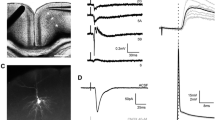Abstract
We have studied in acute experiments the neurons of the associative parietal cortex in the cat, using the microelectrode take-off technique. We identified the efferent neurons sending axons to the sensomotor cortex, the red nucleus, and the pontine nuclei by antidromic stimulation. We investigated the collateral branching of axons of neurons projected simultaneously into two of the formations mentioned, using the impulse collision technique. We studied the characteristics of the spatial distribution of efferent neurons in the parietal cortex.
Similar content being viewed by others
Literature cited
A. S. Batuev, Higher Integral Brain Systems [in Russian], Nauka, Leningrad (1981), p. 255.
V. N. Kazakov and A. M. Dolgopolov, “Convergence of corticofugal impulses on neurons of the bridge of Varolius,” Neirofiziologiya,12, No. 5, 472–480 (1980).
G. A. Tolchenova, “Neuronal organization of cat parietal cortex,” in: Nervous System [in Russian], Leningrad State University (1978), No. 18, pp. 16–30.
V. V. Fanardzhyan and V. L. Gorodnov, “Postsynaptic processes in rubro-spinal neurons of cat brain on different corticofugal actions,” Neirofiziologiya,16, No. 1, 67–74 (1984).
G. I. Allen, H. Korn, T. Oshima, and K. Toyama, “The mode of synaptic linkage in the cerebro-ponto-cerebellar pathway of the cat. II. Response of single cells in the pontine nuclei,” Exp. Brain Res.,24, No. 1, 15–36 (1975).
G. I. Allen and N. Tsukahara, “Cerebro-cerebellar communication system,” Phys. Rev.,54, No. 4, 957–1006 (1974).
H. Asanuma and R. W. Hunspercer, “Functional significance of projection from the cerebellar nuclei to the motor cortex in the cat,” Brain Res.,98, No. 1, 73–92 (1975).
S. Blomfield and D. Marr, “How the cerebellum may be used,” Nature (London),227, No. 5264, 1224–1228 (1970).
R. E. Foster, J. P. Donoghue, and F. F. Ebner, “Laminar organization of efferent cells in the parietal cortex of the Virginia opposum,” Exp. Brain Res.,43, No. 3–4, 330–336 (1981).
J. H. Fuller, “Brain stem reticular units; some properties of the course and origin of the ascending trajectory,” Brain Res.,83, No. 3, 349–369 (1975).
M. Ito, T. Hongo, M. Yoshida, T. Okada, and K. Obata, “Antidromic and transsynaptic activation of Deiters' neurons induced from the spinal cord,” Jpn. J. Physiol.,14, No. 6, 638–658 (1964).
K. Kawamura, “Cortico-cortical fiber connections in the cat cerebrum. II. The parietal region,” Brain Res.,51 (complete), 23–40 (1973).
L. Leinonen, J. Hyvärinen, and A. R. A. Sovijari, “Functional properties of neurons in the temporo-parietal association cortex of awake monkey,” Exp. Brain Res.,39, No. 2, 203–215 (1980).
M. Mabuchi and T. Kusama, “Cortico-rubral projection in the cat,” Brain Res.,2, No. 3, 254–273 (1966).
V. B. Mountcastle, J. C. Lynch, A. Georcopouls, H. Sacata, and C. Acuna, “Posterior parietal association cortex of the monkey; command functions for operations within extrapersonal space,” J. Neurophysiol.,38, No. 4, 871–907 (1975).
H. Oka and K. Jinnai, “Electrophysiological study of parvocellular red nucleus neurons,” Brain Res.,149, No. 1, 239–247 (1978).
K. Sasaki, S. Kawaguchi, T. Shimono, and S. Prelevic, “Electrophysiological studies of the pontine nucleus,” Brain Res.,20, No. 3, 425–438 (1970).
V. Shinoda, C. Chez, and A. Arnold, “Spinal branching of rubrospinal axons in the cat,” Exp. Brain Res.,30, No. 2/3, 203–218 (1977).
P. L. Strick and C. C. Kim, “Input to primate motor cortex from posterior parietal cortex (area 5). I. Demonstration of retrograde transport,” Brain Res.,157, No. 2, 325–331 (1978).
P. Zarzecki, P. L. Strick, and H. Asanuma, “Input to primate motor cortex from posterior parietal cortex (area 5). II. Identification by antidromic activation,” Brain Res.,157, No. 2, 331–336 (1978).
Author information
Authors and Affiliations
Additional information
Translated from Fiziologicheskii Zhurnal SSSR imeni I. M. Sechenova, Vol. 72, No. 7, pp. 865–873, July, 1986.
Rights and permissions
About this article
Cite this article
Popoyan, E.V., Fanardzhyan, V.V. Electrophysiological analysis of efferent neurons of cat associative parietal cortex. Neurosci Behav Physiol 17, 251–258 (1987). https://doi.org/10.1007/BF01191259
Received:
Issue Date:
DOI: https://doi.org/10.1007/BF01191259



